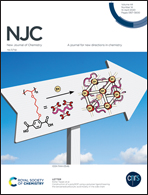An intramolecular 1,5-chalcogen bond on the conformational preference of carbonyl thiocarbamate species†
Abstract
Two closely related compounds, namely, O-methyl (4-fluorobenzoyl)carbamothioate (I) and O-methyl (4-methylbenzoyl)carbamothioate (II) were prepared in good yields by the reaction of the corresponding benzoyl isothiocyanates and methanol. The structural and conformational properties of both compounds were analyzed using a combined approach including single-crystal X-ray diffraction and quantum chemical calculations. A rich conformational landscape is envisaged for the vacuum-isolated species around the central carbamothioate group, with the pseudo-anti conformation (C![[double bond, length as m-dash]](https://www.rsc.org/images/entities/char_e001.gif) O and C
O and C![[double bond, length as m-dash]](https://www.rsc.org/images/entities/char_e001.gif) S double bonds pointing toward opposite orientations) being the most stable form. The X-ray molecular structure shows the presence of this form in the crystalline phase for both compounds. The occurrence of a 1,5-O⋯O intramolecular short distance was observed, suggesting the relevance of chalcogen⋯chalcogen interactions in the conformational preference. Natural bond orbital population analysis and quantum chemical calculations through an isodesmic reaction scheme were applied to better understand the conformational preference and the nature of the O⋯O intramolecular interactions. The quantum theory of atoms in molecules was also used to examine the electronic densities around the S(5) pseudo-ring formed through the intramolecular interaction in the carbamothioate moiety. Furthermore, the vibrational features were analyzed by measuring the infrared and Raman spectra.
S double bonds pointing toward opposite orientations) being the most stable form. The X-ray molecular structure shows the presence of this form in the crystalline phase for both compounds. The occurrence of a 1,5-O⋯O intramolecular short distance was observed, suggesting the relevance of chalcogen⋯chalcogen interactions in the conformational preference. Natural bond orbital population analysis and quantum chemical calculations through an isodesmic reaction scheme were applied to better understand the conformational preference and the nature of the O⋯O intramolecular interactions. The quantum theory of atoms in molecules was also used to examine the electronic densities around the S(5) pseudo-ring formed through the intramolecular interaction in the carbamothioate moiety. Furthermore, the vibrational features were analyzed by measuring the infrared and Raman spectra.



 Please wait while we load your content...
Please wait while we load your content...